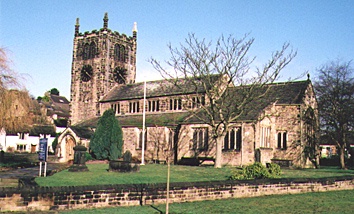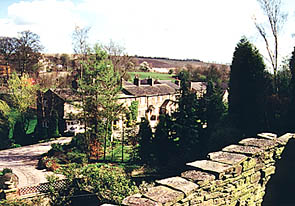Bingley
Bingley - an ancient town in the county of York, has a wealth of history dating back to Saxon times.
Some of its heritage has gone, much remains, and well worth the time taken to wander around its streets and country lanes.
Have a walk down the old Beckfoot Lane to the bridge over the ford, past the farmhouse with its Knight Templars inscription and
lanterns on the roof. The bridge itself was built in 1723 for the princely sum of
£10, on condition that it was fully maintained for seven years. Back along the lane to Myrtle Park,
previously the grounds of Myrtle Grove, Springhead Farm was demolished and, in 1770, Johnson Atkinson built the present
house. In 1772, when his wife Elizabeth's uncle died at Ryshworth Hall, Elizabeth inherited Ryshworth and Johnson
Atkinson added Busfeild to his name. John Wesley visited it and called it his 'Little Paradise'.

All Saints Parish Church
In the Main Street, we can see the Mechanics Institute built in 1864 which has had many uses - School, Town Hall, Library, to
name but a few. On the opposite side of the road, the old Butter Cross, Stocks and Market Hall, first built and situated near the
end of Ferrand Lane in 1753, moved up to Prince of Wales Park in 1888, and was
re-sited in its present position in 1984, thanks to
the efforts of the Bingley Civic Trust.
Down Park Road, once called Toad Lane, you will find the National School opened in 1814, the first of its kind, built on land owned
by the Ferrand Family. At first the Girls' School flourished but the Boys' School
languished! Higher up Park Road, there is the Old Vicarage, near Priesthorpe, the ancient site of the Canons of Drax, the early Vicars of
Bingley. Higher up still, branching to the left is Gawthorpe Hall, with records dating back to the 14th Century.
Up beyond Eldwick, there is Eldwick Hall, dated 1677, once owned by the Knights of Jerusalem, and giving shelter to travellers.
At the top of the stairs to the right, is a chamber isolated from the house, where bread and water were provided.
Continuing up the road we arrive at the Fleece Inn, commonly known as "Dick Hudson's" after a former publican.

Eldwick
Take a look at the Parish Church, which according to records, was built (on possibly an earlier site) by
Wm. Paganell, then Lord of
the Manor, who gave it to the Priory of Drax near Selby, from whence came the early Vicars of Bingley dating from 1228. The
Church houses an old Rune Stone, believed to be Saxon; the bases of the pillars are Norman.
In the Church Yard are one or two interesting gravestones, Hesekiah Briggs, Sexton and
bellringer and Wm. Shaw who for 40 years maintained a wife and numerous issue on 2 shillings per
week wages.
Across the road not far from the tower, there is the "Old Grammar School House", home of its Headmaster. Possibly its best known
resident was Halliwell Sutcliffe, author of "The Striding Dales" and "By Moor and Fell", during the time of his father's tenure of
the headmastership.
Back down the Old Main Street, you will pass the Old White Horse", an old coaching Inn, a popular halt for refreshments
while the horses were being changed. Turn right over Ireland Bridge and up the winding road to St.
Ives, or perhaps first climb the rocky road built by Ferrand up to the Altar Rock, high on the moors, with extensive views of the
valley. St. Ives itself was built on land acquired by the Ferrands in 1639. Up above the house on the edge of the moor is
the memorial to William Busfeild Ferrand, an obelisk situated above 'Lady Blantyres Rock' a favourite spot of his
Mother-in-Law, Lady Blantyre.

The Old White Horse
There are many other places of interest in the town. Walk along the river bank from the bridge to Ravenroyd, an old farmhouse,
once the home of the Quaker families, as early as 1683. Or go under 'Treacle Cock Alley' opposite the church and walk to the
left along the Leeds & Liverpool Canal, opened in 1774 to the 'Three Rise" and then on to the "Five Rise Locks".
Leave the canal at Crossflatts, cross the busy main road and find "Ryshworth Hall", built on an estate which was once extended to
the other side of the valley beyond Greenhill. The house, built in what was then the Deer park, has connections reaching back to
the 14th Century, and was used as a residence for many of the prominent families in the history of Bingley.
Helen Mills.